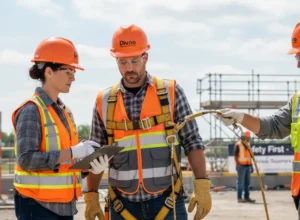Two Ontario companies are facing a combined $175,000 in fines after serious workplace incidents, a stark reminder of the high cost of failing to prevent workplace safety violations. These recent penalties from the Ministry of Labour highlight the critical importance of upholding the province’s Occupational Health and Safety Act (OHSA). For Ontario business owners and HR managers, these headlines are an urgent call to action to audit and reinforce your safety protocols.
At Divino Business Solutions, we know that building a strong safety culture isn’t just about avoiding penalties—it’s about protecting your most valuable asset: your people. Let’s break down what happened and how you can ensure your business demonstrates due diligence and stays compliant.
The High Cost of OHSA Non-Compliance
This past week, the Ministry of Labour, Immigration, Training and Skills Development (MLITSD) publicized two significant penalties against employers for safety infractions.
In Nepean, a home builder was fined $60,000 after a worker fell from a roof and suffered serious injuries. The investigation found a clear failure to ensure fall protection systems were in place, a fundamental and non-negotiable requirement. In a separate case, a Leamington mushroom grower was ordered to pay a $115,000 fine after a worker’s clothing became entangled in an unguarded conveyor belt, resulting in critical injuries.
These are not just unfortunate accidents; they are preventable incidents stemming from a failure to meet basic OHSA standards. The key takeaway for every employer is that fundamental safety measures are your legal responsibility, and overlooking them leads to severe consequences.
Preventing Workplace Safety Violations: Your Key Duties
So, how do you avoid these costly workplace safety violations? It begins with a deep understanding of your duties under the OHSA. Every employer in Ontario must take every precaution reasonable in the circumstances for the protection of a worker. This “general duty clause” is the foundation of a legally defensible health and safety program.
“Proactive safety measures are always more cost-effective than reactive penalties. Investing in a strong safety culture protects your team and your bottom line.”
This broad duty is supported by specific regulations that outline minimum standards. A lack of awareness is not a defense against Ministry of Labour inspections or fines. Proving “due diligence”—the actions you took to prevent incidents—is your primary defense.
A 4-Step Framework for OHSA Compliance
Navigating the OHSA can feel complex, but a structured approach makes compliance achievable. True workplace safety goes beyond a dusty binder on a shelf; it involves creating a living culture of prevention.
1. Conduct Comprehensive Hazard Assessments
You cannot protect workers from hazards you haven’t identified. A thorough hazard assessment is your first step. Systematically review your workplace to identify potential risks, including:
- Physical Hazards: Slips, falls, machine guarding gaps, electrical risks.
- Chemical Hazards: Improper WHMIS labelling or storage.
- Ergonomic Hazards: Repetitive strain, poor workstation design.
- Psychosocial Hazards: Workplace stress, bullying, and harassment.
Once identified, assess the risk level of each hazard and implement control measures to eliminate or reduce it to the lowest possible level.
2. Develop and Document Safe Work Procedures
For every task with an identified risk, you must have a documented Safe Work Procedure (SWP). This is a critical training and enforcement tool. An SWP for operating machinery, for instance, must include pre-operation checks, confirmation that all guards are in place, and emergency shutdown steps. Documenting these procedures is a key part of demonstrating due diligence.
3. Implement Robust Training Programs
Training is your most powerful tool for preventing workplace safety violations. Your program must include:
- Mandatory Awareness Training: For all employees and supervisors.
- Job-Specific Training: On equipment, SWPs, and chemical handling (WHMIS).
- Emergency Procedure Training: Fire evacuations, first aid, and emergency contacts.
Document every training session, including the date, attendees, and topics covered. This record is crucial for proving compliance.
4. Supervise and Enforce
Policies and procedures are only effective if they are followed. Supervisors have a legal duty to ensure workers comply with the OHSA and your company’s safety rules. This means actively monitoring the workplace, correcting unsafe acts, and enforcing your health and safety policy consistently.
What Ontario Employers Should Do Next
The recent fines are a clear signal. Don’t wait for an inspector’s visit or, worse, an injury to take action. Proactive compliance is the only way to protect your business and your team from preventable workplace safety violations.
- Schedule a Full Safety Audit: Within the next 30 days, conduct a comprehensive review of your health and safety policies, procedures, and physical environment. Use Ministry of Labour resources as a guide to identify any gaps.
- Verify Your Training Records: Confirm that every single employee and supervisor is up-to-date on all mandatory and job-specific safety training. Schedule refresher sessions immediately for any areas that are lacking.
- Empower Your JHSC or H&S Rep: Your Joint Health and Safety Committee or representative is your internal safety advocate. Ensure they have the training and resources to conduct regular inspections and bring concerns forward without fear of reprisal.
Need help navigating HR changes? Book your free HR audit today or speak with our team about how Divino can support your business.
Sources
- Government of Ontario. (2025). Court Bulletins. Ontario Newsroom. https://news.ontario.ca/en/court
- Government of Ontario. (n.d.). A Guide to the Occupational Health and Safety Act. https://www.ontario.ca/document/guide-occupational-health-and-safety-act




